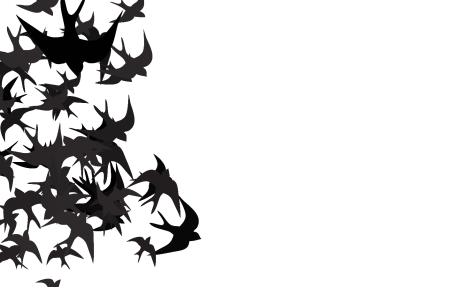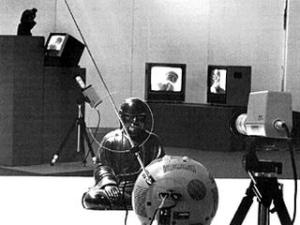August 20, 2008
Categories: Practice and Contextualisation_MADA2 . . Author: Sharon Ferris Web/Graphic Designer . Comments: Leave a comment

MADA Brochure_Design
I worked with Adriano and Katrina on creating the MADA Catalogue,
we wanted a simple design. I used my design skills and created the FLUID LOGO and
MADA 08 Logo. This was an opportunity to team project . I corrospodenent to my fellow
peers on collating infomation that was to be included. (I included an example email of the corrospndence.
Homage_Nam June Paik, «TV-Buddha», 1974
My final year project will visually be in homage to a work by Nam June Paik, «TV-Buddha», 1974.
I will create simply modern day shrine/installation for the particapant to come and experince my work when in a meditative posture (the user will have to sit before my work e.g on a rug,as the shrine (the apple Mac) will be the contempory place of worship. The user will then interact through using a mcirophone to breathe into, which will also be the “mantra” the sound of the breath will be filiterd through head fone so the user can be immeresed into it!
![]() Nam June Paik
Nam June Paik
«TV-Buddha»
Paik’s possibly most famous video work was produced as a gap-filler for an empty wall in his fourth show in the Galeria Bonino, New York. Shortly before the opening, he hit upon the idea of making a TV viewer out of an antique Buddha statue once purchased as an investment. The subsequent addition of a video camera meant the Buddha now watched his videotaped image on the screen opposite – past and present gaze upon each other in an encounter between Oriental deity and Western media.
During the ‘Projekt ’74’ exhibition in Cologne, Paik took the Buddha’s place in his recent creation, suggesting the implicit antithesis between transcendentalism and technology was equally present in his own personality.
Quartz Composer_Feather
I have been experimenting with quartz composer. i decided to use a simple feather as texting the “Replicate in Time” patch in the programme
D Cavallaro ( 2000) Cyberpunk and Cyberculture UK:The Athlone Press
Memory is one of the fundamentals of human capacity that differentiate it from computers.
The book dystopian outlook of future human/cyborg existence living in a homogeneous A-sexual society where life and memory can be downloaded and experiences and encounters can be programmed in a world that is based on simulacra.
Flash_Character Development & Animation:week 2
Making an animatic:
I enrolled on the Flash_Character development & animation 3 week tutorials in order to animate a self
created character.
Frank Popper_From Technological to Virtual Art
The first realm encountered in Osmose is a three-dimensional Cartesian grid, but with the immersant’s first breaths, this gives way to a clearing, surrounded by a forest. One can, through breath, endlessly float through this forest; or enter the clearing’s lone tree and the interior of its leaves; or sink into a pond and its oceanic abyss; or rise above the clearing into the clouds or descend into subterranean depths among translucent roots and rocks.
The immersant also wears a vest that tracks breathing and balance—a strategy intended to reaffirm the role of the subjectively lived body in virtual space.
In short, Davies’s goal is to use virtual reality as a means of temporarily collapsing boundaries between subject and object, interior and exterior, self and world in order to facilitate a refreshing of perception, thereby potentially resensitizing participants to the extraordinariness of being alive, sentient, and embodied, here now, among all this, briefly immersed in the flow of life through space and time.
From Technological to Virtual Art_Frank Popper Cambridge, Massachussetts: The MIT Press (2007)pp. 190-197
Chinese “Magic” Garden
The contemporary style -growing novelty garden is made of paper and plastic and is impregnated with fungi. When the cardboard is immersed in water the
Chemical balance water and air make the fungi’s emerge from the cardboard cut-outs. They come alive and begin to grow into bright bold colours.
The scene of fast growing fungi, reflecting westerns society with speed and immediacy. Having no time to master a process, which in this case in learning the process of mediation and how it can actually
Using you breath as a way to control this process and pause it, if only momentarily. The landscape will be bare until the participate blows at the interface to slowly bring environment to life.
The idea is showing a bleak dead environment and blow life into it. The view of mount Fuji (where is mount Fuji) the spiritual home of Buddhism and where the idea of “Prana” lives. The monks choose spiritual landscapes to mediate in front of.
Westerns societies view on spirituality and eastern philosophies.
It’s a sort of parody of western culture and what we have to worship against consumer Kitsch
What eastern society choose mediate in front of
The Science of Pranayama
The Sanskrit term yoga has a wide range of different meanings. It is derived from the Sanskrit root you, “to control”, “to yoke”, or “to unite”
Several seals discovered at Indus Valley Civilization (c. 3300–1700 BC) sites depict figures in a yoga or meditation like posture Should look at posture for ideas on how user could interact.
Reflection,
I have now come to a time in my project where I want to focus my research. My breathing has been about the process of breath but more specially the idea of living the breath. To abbreviate I wish to look at mediation in which the process is fully used in order to gain re-c connection with ones self and more importantly be within the moment.
The breath
Society spends a lot of time planning for the future of retrospective on the past! What about the here and now. What if we could harness time to enjoy being is present, through current research yogi and more specially
Modern day magic, being able to cure yourself transport yourself through time, become the moment.
The Science of Pranayama
By
Sri Swami Sivananda
First Edition: 1935
Sixteenth Edition: 1997
(6,000 Copies)
© The Divine Life Trust Society
Just as a goldsmith removes the impurities of gold by heating it in the hot furnace, by strongly blowing the blow-pipe, so also the Yogic student removes the impurities of the body and the Indriyas by blowing his lungs, i.e., by practising Pranayama.
When the slender thread-link Prana is cut off the astral body separates from the physical body. Death takes place. The Prana that was working in the physical body is withdrawn into the astral body.
Five Angels for the Millennium, Bill Viola
I am referencing two artists who have pioneered there way in digital art. Bill Viola has created a piece of work called Five Angels for the Millennium, I have chosen this work as it was a reflection on a life changing moment that happened to him as a child of near death experience through drowning.
Viola explains of feeling “magical, extraordinary world, of colour, blues and greens” then caries on to remember the intensity of the feeling “I glimpsed this world, that was one of the most beautiful things I’ve ever seen.”
This profound statement as a young boy has been relived in his work Five “Angels for the Millennium” Dealing with the theme of water and its historical, psychological and spiritual dimensions”
Viola has used this piece to recall a process where he survived nearly dying but could relive it through his art. Viola chooses to create this isolation in slow motion and reverse in order to show the rebirth of the angel rather than the dying. This could be conveyed as and awaking through survining this experiences and the legacy now is how it has filtered into his work and his adult life.
Departing Angel from Five Angels for the Millennium, Bill Viola
(still/detail), 2001 Photo: Kira Perov © Bill Viola.
Artist Bill Viola explains the uncanny origins of his major work, Five Angels for the Millennium, now at Tate Modern
A pioneer of film and video art since the early 1970s, Bill Viola employs both sound and image to profound effect. In Five Angels for the Millennium (2001), five individual video sequences (Birth Angel; Fire Angel; Ascending Angel; Creation Angel; and Departing Angel, pictured) are projected directly onto the walls of a darkened gallery.
‘Five Angels came out of a three day shoot in Long Beach that I had undertaken for several other projects. All I knew was that I wanted to film a man plunging into water, sinking down, below, out of frame – drowning. ‘A year or so later, going through this old footage, I came across five shots of this figure and started working with them – intuitively and without a conscious plan. I became completely absorbed by this man sinking in water, and by the sonic and physical environment I had in mind for the piece.
‘When I showed the finished work to Kira [Perov], my partner, she pointed out something I had not realised until that moment: this was not a film of a drowning man. Somehow, I had unconsciously run time backwards in the five films, so all but one of the figures rush upwards and out of the water. I had inadvertently created images of ascension, from death to birth.’ Bill Viola, 3 June 2003
Source:http://www.tate.org.uk/magazine/issue6/fiveangels.htm
















